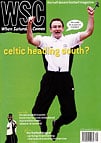 Gillingham have enjoyed a huge transformation since 1992. But getting out of the Football League is almost certainly beyond the limit of their resources, says Haydn Parry
Gillingham have enjoyed a huge transformation since 1992. But getting out of the Football League is almost certainly beyond the limit of their resources, says Haydn Parry
If you had told me a decade ago that Gillingham would finish the 2000-01 season in a comfortable mid-table berth in the First Division, I wouldn’t have believed you – or I would have thought you meant the first division of the Kent League. The past decade has been a golden age for the Gills. After a century of scraping about in the lower divisions (and worse), we’ve pack-ed most of the remarkable moments in the club’s his- tory into ten years. Yet we’re not so intoxicated by our own success that we fail to recognise what is now probably an unbreachable financial gap to the Premiership.
The main aim back in the early Nineties was to avoid the drop into the Conference (something we very nearly failed to do in 1993), as the club slowly slid towards financial oblivion. Yet the Gills emerged from receivership in 1995 with a new owner and attitude and haven’t looked back since. The net result has been two promotions, two Wembley visits and an improved league position in each of the past six campaigns. Then there’s been the bonus of three Premiership scalps in the cups – it’s a measure of how far the club has come that this season when we face Coventry, Bradford and Sheffield Wednesday it will be on equal terms.
The welcome change in fortunes on the pitch hasn’t disguised the harsh financial realities off it. The money flowing through the top tiers of the game hasn’t ever reached the likes of us. Now we’ve got to the First Division, we’ve found the gap to the Premiership is vast and even teams at the top of our table are in a different class. Gillingham’s rise has been achieved within very modest bud- gets. Promotion from the Third was clinched with a side that cost next to nothing and a playing style that was very much the means to an end. Escape from the Second was an altogether different challenge. In the end, the key was a switch from perspiration to inspiration as then manager Peter Taylor ditched the physical for a more pleasing approach.
Whisper it, but the First Division came as a pleasant surprise after all that. Perhaps it was because every game was treated like a cup tie as we entered the uncharted waters of the Hawthorns, City Ground and so on. Perhaps a great many sides believed the bookmakers who made us favourites to come 24th and simply underestimated us. Whichever, 13th place represented our highest League position ever. The challenge now is to keep the miracle going.
Off the pitch, the transformation on matchday has been startling. Priestfield stadium no longer can boast the oldest stand in the League, a Victorian era curiosity-cum-fire hazard. Chairman Paul Scally has overseen the rebuilding of three sides of the old ground and this season the magnificent Medway Stand reaches completion. Even so, ground capacity is tiny by First Division standards (10,500) and a move to a new, bigger home in the Medway Towns remains a long-term possibility. Commercially, the club has been transformed in the Scally era. I can remember ten years ago when “merchandise” consisted of a bloke with a small table of badges and cups standing behind the Rainham End turnstiles. These days there are four stores dotted about the stadium.
Yet matchday income is no longer where the real money is made. The main financial difference from ten years ago is the pure profit the top clubs now get in the form of TV income, albeit offset by the concomitant outlay in players’ wages. The extra £3 million or so the Gills secured in broadcasting rights simply by staying in the First Division this year is undreamt of wealth for us, but chickenfeed to those a flight higher.
Eight former Premiership sides will compete with us in the coming season. One of our competitors this season, Bradford City, had a players’ wage bill of £13 million last season – and that’s well below the going Premiership rate. Carl Asaba departed for Sheffield United last season complaining that Gillingham still offered Second Division wages – on that score, as in the transfer market, it would seem that we are well and truly outgunned. To remain competitive, the club still relies on shrewd transfer-market dealings with the lower division sides.
Meanwhile, the gap between the top teams in the First Division and the rest is growing. The non-competitive canter to the finishing line by the top two last season simply wasn’t healthy. The Gills’ deserved win at Ewood Park shouldn’t have felt like an unlikely cup shock but it did – in terms of players and facilities, Rovers are on another planet.
Likewise, I can recall the Gills thrashing a hopeless Fulham side in the Third Division just seven years ago – fast forward to Priestfield in 2001 and their fans were gleefully taunting “We’ll never play you again” during a routine away win. Fulham may be ready for the spiralling financial demands of the top flight but, for all their progress, the Gills will have to settle for consolidation in the First. And we are not alone. That’s likely to be the limit of ambition for a lot of clubs in the Football League for the foreseeable future.
From WSC 175 September 2001. What was happening this month